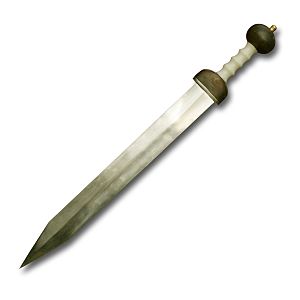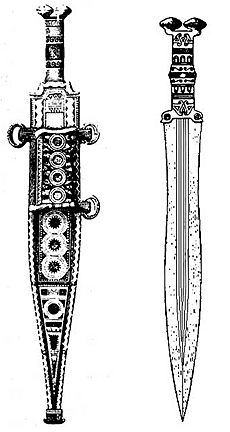Gladius facts for kids
Quick facts for kids Gladius |
|
|---|---|
|
Replica pseudo-Pompeii gladius
|
|
| Type | Sword |
| Place of origin | Rome, Italy as gladius, based on the Celtiberian gladius hispaniensis. |
| Service history | |
| In service | 3rd century BC – 3rd century AD |
| Used by | Roman foot soldiers during wars |
| Wars | Roman Republic and Roman Empire |
| Specifications | |
| Mass | 0.7–1 kg (1.5–2.2 lb) |
| Length | 60–85 cm (24–33 in) |
| Blade length | 45–68 cm (18–27 in) |
| Width | 5–7 cm (2.0–2.8 in) |
|
|
|
| Blade type | Iron of varying degrees of carbon content, pointed, double-edged |
| Hilt type | Wood, bronze or ivory |
The gladius was a short sword used by soldiers and gladiators in Ancient Rome. The Romans copied its design from swords they saw the Celtiberians using. This happened during the Second Punic War, a big conflict between Carthage and Rome (218–201 BC).
Contents
What is a Gladius?
The word gladius simply meant "sword" in Latin. People used this word for any type of sword.
Gladii had two sharp edges for cutting. They also had a pointed tip for stabbing enemies. The handle, called a hilt, often had a knob. This knob helped soldiers hold the sword firmly. Sometimes, the hilt even had ridges for fingers.
The blade was made strong by welding strips of metal together. Some blades were made from a single piece of steel. The owner's name was often carved into the blade.
The Hilt and Scabbard
The hilt of a Roman sword was called the capulus. Officers and important people often had very fancy hilts.
Soldiers carried the gladius in a scabbard. This was a case for the sword, attached to a belt or shoulder strap. Most soldiers wore it on their right side. This meant they had to reach across their body to draw it. A centurion, a Roman army officer, wore it on his left side. This showed his special rank.
Over time, other types of swords slowly replaced the gladius. This happened around the 2nd and 3rd centuries AD.
Where Did the Gladius Come From?
Before the gladius, Roman soldiers used swords that were good for thrusting. These might have been like the Greek xiphos sword.
During the Battle of Cannae in 216 BC, Romans fought against Celtiberians. These Celtiberian fighters used swords that were great for both cutting and stabbing. The Romans were impressed.
Adopting the New Sword
A writer named Polybius says the Romans soon adopted this new sword design. They even called it the gladius hispaniensis, which means "Hispanic sword." This name came from Hispania, which is modern-day Spain.
It's believed that Scipio Africanus, a famous Roman general, helped make this change happen. After the Battle of Cartagena in 209 BC, he made the local people produce weapons for the Roman army.
Some historians think the Romans might have adopted the Celtiberian sword even earlier. This could have been during the First Punic War (264-241 BC). However, the gladius hispaniensis became very well known around 200 BC. This was during the Second Macedonian War. Macedonian soldiers were shocked by how powerful Roman swords were.
New discoveries show that early Roman gladii looked very much like Celtiberian swords. This supports the idea that the Romans copied them. These Celtiberian swords were unique in their design.
How Gladii Were Made
During the Roman Republic, people knew how to make steel. Pure iron is soft, but iron ore found in nature has other materials mixed in. These make the metal harder. The gladius was usually made from steel.
Roman workers used a special furnace called a bloomery. This furnace turned iron ore into pieces called blooms. Workers then hammered these blooms. This removed impurities and made the metal stronger.
Ancient Sword Making
Scientists have studied old swords from the Etruscans. The Etruscans lived in Italy before the Romans. One sword, from the 4th century BC, looked like a gladius Hispaniensis. This suggests that the way swords were made continued from the Etruscans to the Romans.
One Etruscan sword was made by welding five strips of metal together. Each strip had a different amount of carbon. The middle of the sword had more carbon, making it harder. The edges had less carbon. The pieces were hammered together while hot.
Another Etruscan sword was made from a single piece of metal. The amount of carbon in the blade increased towards the sharp edge. This made the blade harder.
Romans continued to make swords in both ways. They used both single pieces and multiple pieces welded together. Sometimes, sand or rust got into the metal. This made the swords weaker than they could have been.
Different Types of Gladii
There were several different designs of the gladius. Today, collectors and people who reenact history know three main types. These are the Mainz gladius, the Fulham gladius, and the Pompeii gladius. Their names come from where good examples of them were found.
More recently, archaeologists found an even older version. This is the gladius Hispaniensis.
Subtle Differences
The differences between these swords are small.
- The original gladius Hispaniensis had a slight curve, like a "wasp-waist" or a leaf.
- The Mainz gladius was used in the early Roman Empire. It kept the curve but had a shorter, wider blade. Its point was triangular.
- The Pompeii gladius was used more at home. It had no curve and a longer blade. Its point was smaller.
- The Fulham gladius was a mix of these designs. It had straight edges and a long point.
Images for kids
See also
 In Spanish: Gladius para niños
In Spanish: Gladius para niños






